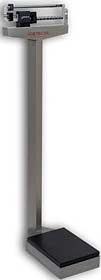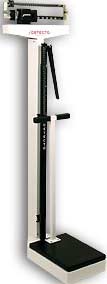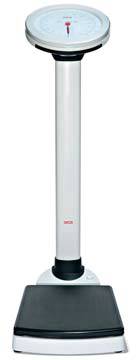Home » Hospital & Durable Medical Equipment » Column Scales For Different Uses » Column Scales For Different Uses
Column Scales For Different Uses

Stainless Steel Mechanical Physician Scale In Kgs w/ Height Rod
Retail Price: $921.99
Your Price: $730.00
 Unit: single
Unit: single

Mechanical Physician Scale In Lbs w/ Height Rod & Handpost
Retail Price: $367.20
Your Price: $296.69
 Unit: single
Unit: single

Seca Mechanical Column Scale w/ BMI Display
Retail Price: $845.78
Your Price: $721.89
 Unit: single
Unit: single
Column scales are traditional devices in medical settings. However, technology and advancements in design have allowed these tried and true devices, like almost all other equipment, to become much more user friendly. With an estimated 82.2% of the adult population seeing a physician in a 12 month period speed and ease of equipment use is a must. This percentage works out, according to the Centers for Disease Control and Prevention, to a whopping 1.2 billion ambulatory care visits per year.
For column scales that are very easy to use and require little maintenance are a great option. Keep in mind that many people will use the device each day so the simplest operation option is the best. Digital LED displays that quickly show the person his or her weight are a great match. Many of these types of models have a display that can be positioned at the average waist level for ease of reading. Other models may also offer higher chin level readout that is a good match for adults but not necessarily for younger people.
For precision accuracy both digital as well as mechanical models are a good option. The mechanical options, also known as beam scales, allow the individual or staff member using the scale to manually set the weights along the beam. When the beam is in balance the weight is then read off the scale. This involves a few additional steps including understanding how to correctly use the device. Many people don't understand how to balance the scale and how to read the weights since you do need to add the values from the heavy weight and the lighter weight together to get the total weight. Beam scales also require that the weights be set back to zero between uses, something that may be difficult when untrained people are using the equipment.
The other major advantage to a digital readout, particularly for home use or use in a medical facility is that data can be stored or printed. For the home user or smaller clinic this is an excellent way to easily recall the last reading. Printouts can be used in charting or measuring success including weight loss or gain, depending on the specific goals of the patient. Many doctors are now advising patients to use BMI or Body Mass Index measurements as opposed to just focusing in on weight. Digital column scales may be capable of immediately calculating BMI once the individual's height is keyed into the system. The height information can be stored for future use and reference.
Another model to consider are column scales that provide a dial that is easy to read. This is similar to a traditional type of scale where the needle moves to point to the weight amount. New models options may also provide a BMI readout that is activated when the person steps onto the scale platform. If a height measuring rod is attached to the side the person can very quickly and accurately determine their weight and BMI all on one easy to read dial system.
Mobility and ease of transport for column or beam scales is important in most settings. Look for models that offer built in castors for easy of movement without the need to recalibrate the scale. Some models have self-leveling feet that are perfect for use on any type of floor, including tile or irregular surfaces.
Choosing column scales that are highly accurate in patient care or weight loss applications is seen as critical to patient success. When the device is not accurate or calibrated properly the person using the scales will not have accurate information about their success in their program. Look for devices that offer a self-calibration option or that can be calibrated as needed to ensure the highest level of accuracy.














